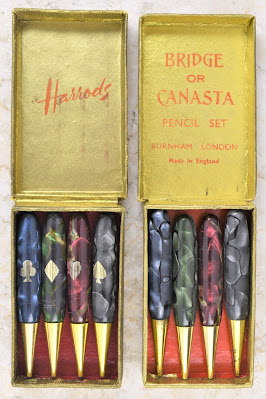This article has been edited and included in The Leadhead's Pencil Blog Volume 6, now on sale at The Legendary Lead Company. I have just a few hard copies left of the first printing, available here, and an ebook version in pdf format is available for download here.
If you don't want the book but you enjoy this article, please consider supporting the Blog project here.
There’s two types of “bridge pencils.” In America, they usually took the form of pencils with on-board scoring “cheat sheets,” like those ones bearing a seal of approval from Ely Culbertson, bridge-playing rock star of the 1930s (see "Bridge Player of the Century").
Overseas, bridge pencils were less gimmicky and more genteel sets of four pencils, representing the four card suits, one for each player in a game of contract bridge. They were typically packaged in nice cases, to be brought out ceremoniously like fine china for a more formal sort of social occasion.
And, since they typically aren’t American, they fall outside my self-imposed collecting bailiwick. “Two’s a coincidence and three’s a collection” has been my mantra, which is why as late as 2015 I was still counting these as “two” (see"This Counts as Two, Right?"):
These sets were made by English maker Burnham; the Canasta set is so marked, and the set marked “Harrod’s” inside the box lid was marketed by the London department store by that name.
The fiction that I don’t collect these has long since collapsed, and I’m keen on finding nice bridge sets regardless of their country of manufacture. The first picture in this article is from the box lid of a set that recently came my way via Jerome Rosenthal:
While Mabie Todd & Co. is a firm with American origins, the “Ltd.” at the end designates its British operations, and the pencils are clearly continental. They have triangular barrels, and the colors are just spectacular:
And unlike the Burnham sets, these pencils sport imprints. Even if they didn’t I wouldn’t question whether these are Mabie Todds, but it doesn’t hurt to have that extra little bit of confirmation:
“‘DACE’ / Mabie, Todd & Co. Ltd. / Registered No. 728198.” It’s frustrating trying to find information concerning British registrations; they consider such historical information over there to be a profit center. One day I aspire to do for British patents and trademarks what I’ve been able to do over here, where free access facilitated the creation of the reference books I needed. Unfortunately, without spending a considerable amount of money on British records, a registration number like this is about as useful as a bicycle is to a fish, so the saying goes.
A rant for another day, I suppose.
Here’s another British bridge set, which Joe Nemecek gifted to me:
I used to think this was a much older set which had been rehoused in something much newer, since the pencils look like something from the turn of the last century. Quite a coincidence though, to find a perfectly sized case with four perfectly sized bands to hold these:
The hallmarks tell me that this is all original and as it should be. It’s quite a bit newer than it looks, and newer also than nearly everything in my collection:
The three stamps in the middle are traditional English silver hallmarks, which have been in use for hundreds of years. The one on the left is an anchor, denoting Birmingham assay office. The lion denotes sterling silver (and is a duplicate of the more recent “925" marks on the right). The important one is that script E, which is the date code corresponding to 1979.
As for the “W.M” at the beginning, that is the manufacturer’s hallmark. The only one I found operating in Birmingham in 1979 was William Manton, also known as Birmingham Gold & Silversmiths, Ltd.
The lure of matching pencils with card suits even pulls me in when they are more humble; these came in a box marked “Germany” but are otherwise unidentified:
Then there’s this set, which turned up at the DC show a couple years ago.
There’s no markings on the pencils other than “Foreign” (meaning foreign to the UK, into which they were imported), and they combine American kitch with a bit of European flair: four pencils, each marked with all four suits and bearing on-board cheat sheets, accompanied with a nice metal plate with an “Honor Column” and brief description of penalties. At the tops, square inserts prevent these clipless pencils from rolling, which might suggest “Foreign” meant brought back to the crown from the former colonies – that’s just like what you’ll see on the Vanco bridge pencil (see "Trick Pencils . . . For Tricks").
Here in the states, where the Slencil company turned out these “Stag Slencil” bridge sets (featured here back in 2013, see The Leadhead’s Pencil Blog Vol. 2, page 247):
Slencil was one of the few American companies turning out four pencil sets like the ones in Europe, but an article such as this wouldn’t be complete without including the American royalty on the subject:
Resting comfortably in a corner of the museum is Parker’s offerings on the subject: the bridge set consisting of four enameled and separately boxed bases, with red and black golf pencils. I’ve written about these more continental sets before (see The Leadhead’s Pencil Blog, Vol. 1 at page 300 and Vol. 2 at page 137), and also about Parker’s scoring pencils in the foreground (those weird triangular pencils with red round tops - see Vol. 1, page 318 and more recently, at "Bridging the Gap").
I don’t have anything new to add about the Parker stuff – it just didn’t seem right to post an article about bridge sets without including them.
PS - Joe Nemecek has a similar affinity for things like this - check out his post over at Joe's Pencil Pages: Joe's Bridge sets.














No comments:
Post a Comment